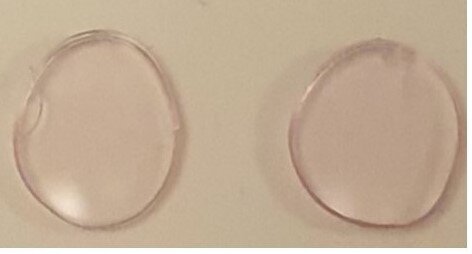 ACS Nano 2021, DOI: 10.1021 / acsnano.0c09657 “width =” 472 “height =” 254″/>
ACS Nano 2021, DOI: 10.1021 / acsnano.0c09657 “width =” 472 “height =” 254″/> Rose-colored contact lenses (about 10 mm in diameter) containing gold nanoparticles filter problematic colors for people with red-green color blindness. Credit: Adapted from ACS Nano 2021, DOI: 10.1021 / acsnano.0c09657
Imagine seeing the world in muted shades – gray sky, gray grass. Some people with color blindness see everything that way, although most may not be able to see specific colors. Colored glasses can help, but they can not be used to correct blurred vision. And colored contact lenses currently being developed for the condition are potentially harmful and unstable. Well, in ACS Nano, researchers report that contact lenses with gold nanoparticles are applied to create a safer way to see colors.
Some daily activities, such as determining if a banana is ripe, choosing matching clothes, or stopping at a red light, can be difficult for those with color blindness. Most people with this genetic disorder have trouble distinguishing between red and green shades, and wearing red tinted glasses can see the colors more prominently and more easily. However, these lenses are bulky and the lens material cannot be made to solve vision problems. So researchers have moved on to the development of special tinted contact lenses. Although the prototype warm-pink colored lenses improved red-green color perception in clinical trials, they leached dye, leading to concerns about their safety. Gold nanocomposites are non-toxic and have been used for centuries to produce ‘cranberry glass’ due to the way they disperse light. So Ahmed Salih, Haider Butt and colleagues wanted to see if the use of gold nanoparticles in contact lens material instead of dye could safely and effectively improve the red-green contrast.
To make the contact lenses, the researchers mixed gold nanoparticles evenly in a hydrogel polymer to produce rosy gels that filtered light within 520-580 nm, the wavelengths where red and green overlap. The most effective contact lenses were those with 40 nm-wide gold nanoparticles, because in tests these particles did not shrink or filter more color than needed. In addition, these lenses have water retention properties similar to those of commercial ones, and were not toxic to cells growing in petri dishes in the laboratory. Finally, the researchers directly compared their new material with two commercially available pairs of tinted glasses and their previously developed warm pink colored contact lens. The gold nanocomposite lenses were more selective in the wavelengths they blocked than the glasses. The new lenses matched the wavelength of the colored contact lenses, indicating that the gold nanocomposite is suitable for people with red-green color problems without the possible safety issues. According to the researchers, the next step is to conduct clinical trials with human patients to determine comfort.

Credit: American Chemical Society
New development in contact lenses for red-green color blindness with simple dye
Ahmed E. Salih et al. Gold nanocomposite contact lenses for color blindness management, ACS Nano (2021). DOI: 10.1021 / acsnano.0c09657
Provided by American Chemical Society
Quotation: Contact lenses that correct color blindness (2021, March 3) Obtained March 4, 2021 from https://phys.org/news/2021-03-blindness-correcting-contact-lenses.html
This document is subject to copyright. Except for any fair trade for the purpose of private study or research, no portion may be reproduced without the written permission. The content is provided for informational purposes only.
